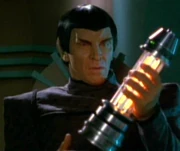m (Robot: Automated text replacement (-Image: +File:) !!wikia-credits fix!!) |
Mdettweiler (talk | contribs) (clarified difference between duranium test cylinders as described in "Hollow Pursuits" and the more advanced ones from "Eye of the Needle") |
||
| Line 1: | Line 1: | ||
[[File:Telek_R'Mor_holds_test_cylinder.jpg|thumb|Dr. [[Telek R'Mor]] holds a Starfleet test cylinder]] |
[[File:Telek_R'Mor_holds_test_cylinder.jpg|thumb|Dr. [[Telek R'Mor]] holds a Starfleet test cylinder]] |
||
| − | A [[Starfleet]] '''test cylinder''' was a standard [[24th century]] mechanism with a varietal [[molecule|molecular]] matrix that simulates most known [[organic]] and [[inorganic]] compounds. |
+ | A [[Starfleet]] '''test cylinder''' was a standard [[24th century]] mechanism used to test the correct working of a [[transporter]]. Multiple types of test cylinders were available, including pure [[duranium]] models, and other more advanced ones with a varietal [[molecule|molecular]] matrix that simulates most known [[organic]] and [[inorganic]] compounds. ({{TNG|Hollow Pursuits}}; {{VOY|Eye of the Needle}}) |
| − | + | Test cylinder [[technology]] was not classified and the [[Romulan]]s had a similar device during the [[2350s]]. ({{VOY|Eye of the Needle}}) |
|
| − | |||
| ⚫ | |||
| ⚫ | Test cylinders were used in [[2366]] in an effort to overcome the effects that [[hyperonic radiation]] had on transporters. [[chief engineering officer|Chief engineer]] [[Geordi La Forge]], [[ |
||
| − | |||
| ⚫ | Following the discovery of a [[micro-wormhole]], proposed by [[Tom Paris]] to be named the [[Harry Kim wormhole]], in the [[Delta Quadrant]] by the {{USS|Voyager}} in [[2371]], it was determined that a transporter signal could be transmitted via a [[microprobe]] relay lodged in the micro-wormhole, towards to other end. With the assistance of a [[signal amplifier]] aboard the [[Romulan science vessel]] ''[[Talvath]]'', located in the [[Alpha Quadrant]], a test cylinder was used to determine the safety of the transport. |
||
| − | |||
| − | After more than twenty successful transports it was deemed safe to transport a test subject through the micro-wormhole. ({{VOY|Eye of the Needle}}) |
||
| ⚫ | |||
| ⚫ | Test cylinders were used in [[2366]] in an effort to overcome the effects that [[hyperonic radiation]] had on transporters. [[chief engineering officer|Chief engineer]] [[Geordi La Forge]], [[transporter chief]] [[Miles O'Brien]] and [[Provisional officer|Acting Ensign]] [[Wesley Crusher]] went through several test cylinders before realizing that it would take years of research and about one hundred personnel to make it work. ({{TNG|The Ensigns of Command}}) |
||
| ⚫ | Following the discovery of a [[micro-wormhole]], proposed by [[Tom Paris]] to be named the [[Harry Kim wormhole]], in the [[Delta Quadrant]] by the {{USS|Voyager}} in [[2371]], it was determined that a transporter signal could be transmitted via a [[microprobe]] relay lodged in the micro-wormhole, towards to other end. With the assistance of a [[signal amplifier]] aboard the [[Romulan science vessel]] ''[[Talvath]]'', located in the [[Alpha Quadrant]], a test cylinder was used to determine the safety of the transport. After more than twenty successful transports it was deemed safe to transport a test subject through the micro-wormhole. ({{VOY|Eye of the Needle}}) |
||
[[Category:Tools]] |
[[Category:Tools]] |
||
Revision as of 18:32, 1 August 2010

Dr. Telek R'Mor holds a Starfleet test cylinder
A Starfleet test cylinder was a standard 24th century mechanism used to test the correct working of a transporter. Multiple types of test cylinders were available, including pure duranium models, and other more advanced ones with a varietal molecular matrix that simulates most known organic and inorganic compounds. (TNG: "Hollow Pursuits"; VOY: "Eye of the Needle")
Test cylinder technology was not classified and the Romulans had a similar device during the 2350s. (VOY: "Eye of the Needle")

A duranium test cylinder, circa 2366
Test cylinders were used in 2366 in an effort to overcome the effects that hyperonic radiation had on transporters. Chief engineer Geordi La Forge, transporter chief Miles O'Brien and Acting Ensign Wesley Crusher went through several test cylinders before realizing that it would take years of research and about one hundred personnel to make it work. (TNG: "The Ensigns of Command")
Following the discovery of a micro-wormhole, proposed by Tom Paris to be named the Harry Kim wormhole, in the Delta Quadrant by the USS Voyager in 2371, it was determined that a transporter signal could be transmitted via a microprobe relay lodged in the micro-wormhole, towards to other end. With the assistance of a signal amplifier aboard the Romulan science vessel Talvath, located in the Alpha Quadrant, a test cylinder was used to determine the safety of the transport. After more than twenty successful transports it was deemed safe to transport a test subject through the micro-wormhole. (VOY: "Eye of the Needle")
